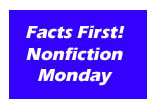Writing Non-Fiction for Children is hosting Non-Fiction Monday this week. Click HERE to check out the other great posts.
Bees are fascinating creatures. It amazes me how they work together in their flourishing colony in perfect harmony—each bee with its own role, from caregiver to honey hunter. When I study a topic like bees, it affirms for me the existence of an intelligent and imaginative creator. It makes me more in awe of Him.
In school, science felt boring and seemed abstract. Picture books, though, foster an interest and provide concrete models foundational for later scientific study. Even if you have “older” children, check out some picture books to go along with a school or home study. You might just find a new level of enthusiasm!
The Honey Bee’s Hive: A Thriving City (ages 8 and up) by Joyce Markovics
(ages 8 and up) by Joyce Markovics 
I have enjoyed several books in the Spectacular Animal Towns series by Bearport publishing. Like the others, The Honey Bee’s Hive reveals the mysteries of the bees with amazing, vibrant photographs and captivating text. The essential role of the honey bee is set up with an anecdote and pictures of bees being brought in to pollinate almond trees in California to help ensure an abundant crop. Moving into the general information, readers learn about their habitat, home, and communication as well as the process of changing nectar into honey. One of the most intriguing sections is the life cycle of these insects. Photographs of the bees from egg to developing pupae accompany the well-written text. Rounding out the book, a brief look into the dangers that threaten bees. The Honey Bee’s Hive: A Thriving City is my top pick for resources on the topic.
Watch It Grow: Bee  (ages 5 and up) Barrie Watts
(ages 5 and up) Barrie Watts 
With eye-catching original photographs and straightforward text, Watch It Grow Bee focuses primarily on the life-cycle of the insect. Readers watch as the bees grow from egg to adult. Several key areas of the adult bee’s life are shown, such as looking for food, pollinating flowers, storing the food, and sustaining the colony. The large font and straightforward text is perfect for early readers who are becoming comfortable reading multiple sentences on a page.
World of Insects: Honey Bees (ages 3-7) by Colleen Sexton
(ages 3-7) by Colleen Sexton 
World of Insects: Honey Bees offers a basic look at the insect. The first section focuses on the parts of the bee while the second illustrates bees collecting nectar and pollinating flowers. The process of changing nectar to honey is mentioned but not described in detail. Each page has a large, dazzling photograph to accompany 1-2 sentences of text. This Blast Off! Reader can be used as an introduction for preschoolers and/or an early reader for older children.
Honorable Mention
Bees and Their Hives (ages 3-7) by Linda Tagliaferro
(ages 3-7) by Linda Tagliaferro
Each two-page spread has 1-2 simple sentences and one large photograph. A snapshot glimpse into building a hive and the workings of it are depicted. Like World of Insects: Honey Bees, Bees and Their Hives, it can be used as an introduction for preschoolers or as an early reader.








No comments:
Post a Comment